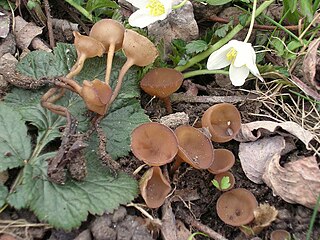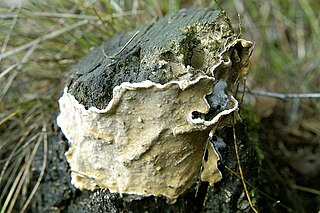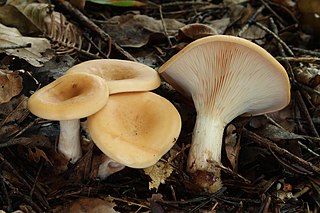Boudierella is a genus of fungi in the family Pyronemataceae.
Coppinsia is a genus of lichenized fungi in the family Trapeliaceae. This is a monotypic genus, containing the single species Coppinsia minutissima.
Cejpia is a genus of fungi in the family Dermateaceae. The genus, named in honour of Czech mycologist Karel Cejp, contains two species.

Dumontinia is a fungal genus in the family Sclerotiniaceae. The genus is monotypic, containing the single species Dumontinia tuberosa, found in Europe.
Ingaderia is a genus of lichen-forming fungi in the family Opegraphaceae. The genus was circumscribed by British botanist Otto Vernon Darbishire in 1897.
Engleromyces is a genus of fungi in the family Xylariaceae. The genus contains two species, the type Engleromyces goetzei and E. sinensis, described as new in 2010. The genus was circumscribed in Bot. Jahrb. Syst. Vol.28 on page 327 in 1900 by German mycologist Paul Christoph Hennings.
Colensoniella is a genus of fungi in the class Dothideomycetes. The relationship of this taxon to other taxa within the class is unknown. A monotypic genus, it contains the single species Colensoniella torulispora.
The Elixiaceae are a family of fungi in the order Umbilicariales. It contains two genera, Meridianelia, and the type genus, Elixia, which together have a total of three species. The family was circumscribed by lichenologist Helge Thorsten Lumbsch in 1997.

Descolea is a genus of fungi in the family Bolbitiaceae. Described by mycologist Rolf Singer in 1952, the widespread genus contains about 15 species. It was formerly placed in the family Cortinariaceae because of its limoniform basidiospores and its ectomycorrhizal lifestyle. A 2013 molecular phylogenetics study by Tóth et al. found it to be closely related to the genus Pholiotina The genus Pseudodescolea, erected for the single Descolea-like species Pseudodescolea lepiotiformis, was formerly considered distinct until a 1990 study found it to be a synonym of Descolea antarctica.
Austroclitocybe is a genus of fungi in the family Tricholomataceae. The genus is monotypic, containing the single species Austroclitocybe veronicae, found in temperate South America. The genus was circumscribed by Jörg H. Raithelhuber in 1972.
Dennisiomyces is a genus of fungi in the family Tricholomataceae. Described by mycologist Rolf Singer in 1955, the genus contains five species found in South America.

Fayodia is a genus of fungi in the family Tricholomataceae. It was first described by Robert Kühner in Bull. Bi-Mens. Soc. Linn. Lyon Vol.9 on page 68 in 1930, and the specific epithet honors the Swiss mycologist Victor Fayod (1860–1900). The widespread genus contains 10 species, mostly in the northern temperate regions.

Clitocybula is a genus of mushroom-forming fungi in the family Marasmiaceae. The genus was circumscribed by Georges Métrod in 1952. Species in the genus are commonly known as "coincaps".
Grosmannia is a genus of fungi in the family Ophiostomataceae. It was circumscribed by G. Goidànich in 1936.

Eichleriella is a genus of fungi in the family Auriculariaceae. The genus has a widespread distribution and contains about seven species.
Burgella is a genus of fungi in the family Clavulinaceae. The genus is monotypic, containing the single species Burgella flavoparmeliae, described in 2007.
Frommeella (Frommeëlla) is a genus of rust fungi in the family Phragmidiaceae. The widespread genus contains two species.
Fischerula is a genus of two truffle-like fungi in the family Morchellaceae. First described from central Italy by Oreste Mattirolo in 1928, the genus name honors Swiss mycologist Eduard Fischer. The type species Fischerula macrospora is known only from Italy, while Fischerula subcaulis is found in coniferous and mixed forests of Oregon and Washington.

Paralepista is a genus of mushrooms in family Tricholomataceae. Until 2012 its member species were generally assigned either to Lepista or to Clitocybe.






